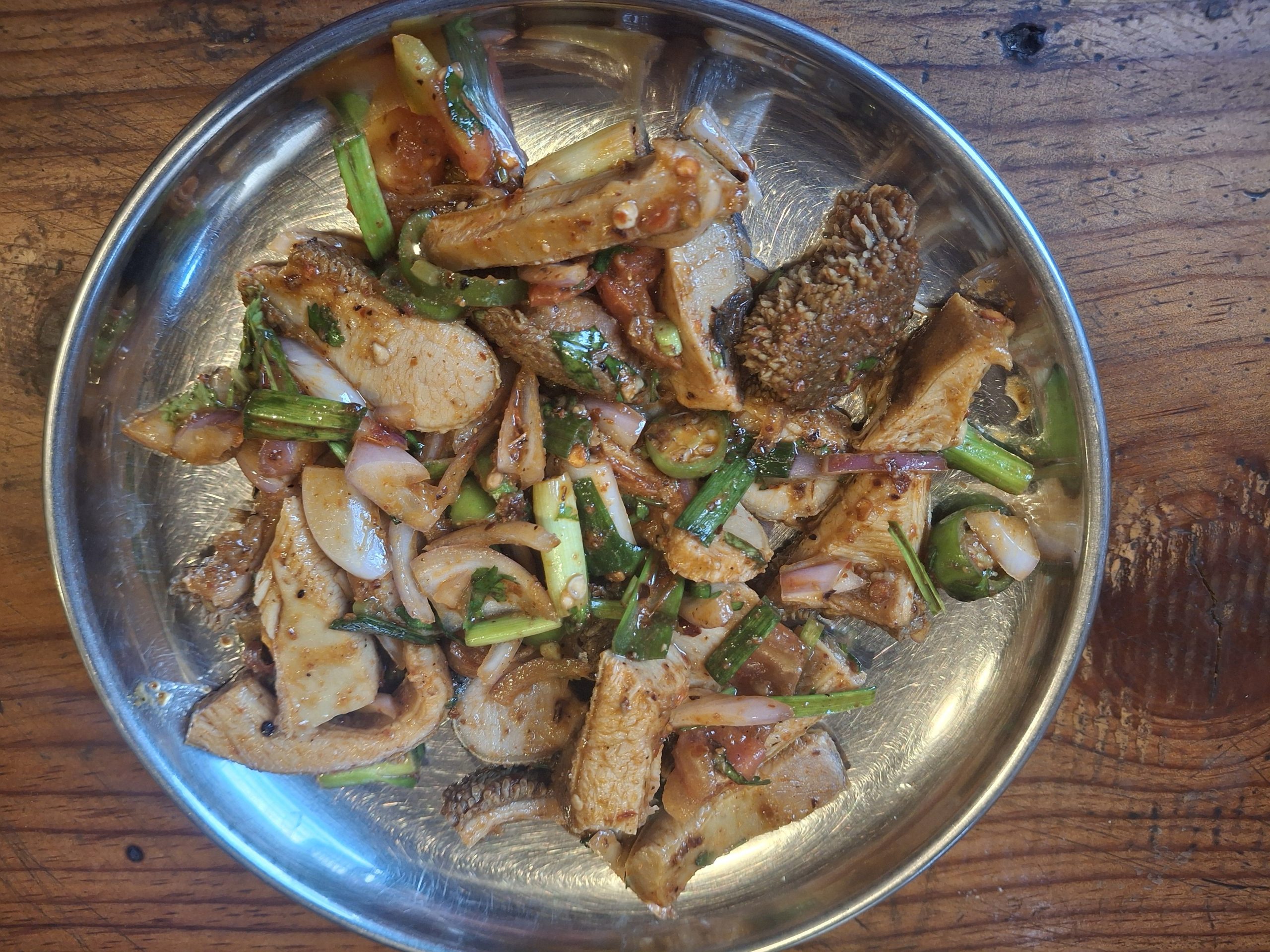Khago Sandeko

Khago Sandeko is a fiery and flavorful dish from the Newari cuisine of Nepal, known for its bold spices and unique preparation. This traditional delicacy, often made with buffalo intestines, is a staple in Newari feasts and celebrations, reflecting the rich culinary heritage of the Newar community in Kathmandu Valley. The dish is a type of “sandeko,” meaning a mixed or tossed salad, typically served cold or at room temperature, with a pungent and spicy profile that delights meat lovers. Below, we dive into the cultural significance of Khago Sandeko and share an authentic recipe to bring this Newari gem to your kitchen.
Cultural Significance of Khago Sandeko
The Newari people, indigenous to the Kathmandu Valley, are renowned for their distinct food culture, which blends locally available ingredients with time-honored techniques. Khago Sandeko, featuring buffalo intestines (khago), is a testament to their resourcefulness, utilizing every part of the animal to create a dish that’s both economical and delicious. It’s commonly served during festivals, family gatherings, and special occasions, often paired with beaten rice (chyura) or traditional Newari rice beer (chyang). The dish’s intense flavors—spicy, tangy, and aromatic—embody the Newari love for bold, complex tastes, making it a standout in their culinary repertoire.
Khago Sandeko Recipe
This recipe is adapted from traditional Newari methods, ensuring authenticity while being approachable for home cooks. Note that preparing Khago Sandeko requires thorough cleaning of the intestines, a crucial step to achieve the right texture and flavor. If buffalo intestines are unavailable, you can substitute with other offal like chicken gizzards, though the taste will differ slightly.
Ingredients (Serves 4)
-
Buffalo intestines (khago): 500 grams, thoroughly cleaned
-
Red onion: 1 large, thinly sliced
-
Green chilies: 2–3, finely chopped (adjust to taste)
-
Ginger: 1-inch piece, julienned or finely grated
-
Garlic: 4–5 cloves, minced
-
Tomato: 1 medium, finely chopped
-
Fresh coriander (cilantro): 2 tablespoons, chopped
-
Mustard oil: 2 tablespoons (raw, for authentic flavor)
-
Ground spices:
-
Cumin powder: 1 teaspoon
-
Coriander powder: 1 teaspoon
-
Red chili powder: 1 teaspoon (adjust to taste)
-
Turmeric powder: 1/2 teaspoon
-
-
Salt: To taste
-
Lemon juice: 1 tablespoon (optional, for tanginess)
-
Fenugreek seeds: 1/2 teaspoon (for tempering)
-
Sichuan pepper (timur): 1/2 teaspoon, ground (optional, for a citrusy kick)
Instructions
-
Clean the Intestines:
-
Rinse the buffalo intestines thoroughly under cold water, turning them inside out to clean all surfaces.
-
Soak in water with a splash of vinegar or lemon juice for 15–20 minutes to remove any odor.
-
Scrub gently with salt, rinse again, and repeat until the intestines are clean and odor-free.
-
Boil the intestines in a pot of water with a pinch of turmeric and salt for 30–40 minutes until tender but not mushy.
-
Drain, cool slightly, and cut into bite-sized pieces (about 1-inch long).
-
-
Prepare the Spice Mix:
-
In a small bowl, combine cumin powder, coriander powder, red chili powder, turmeric powder, and ground Sichuan pepper (if using). Set aside.
-
-
Temper the Oil:
-
Heat 1 tablespoon of mustard oil in a small pan over medium heat.
-
Add fenugreek seeds and let them sizzle until they turn dark brown (be careful not to burn them).
-
Remove from heat and let the oil cool slightly.
-
-
Assemble the Sandeko:
-
In a large mixing bowl, combine the boiled intestine pieces, sliced red onion, chopped green chilies, ginger, garlic, and tomato.
-
Sprinkle the prepared spice mix and salt over the ingredients.
-
Pour the tempered mustard oil (with fenugreek seeds) over the mixture.
-
Add the remaining 1 tablespoon of raw mustard oil for extra pungency.
-
Toss everything together thoroughly, ensuring the spices coat the intestines evenly.
-
Add lemon juice (if using) and chopped coriander, and mix again.
-
Taste and adjust salt or chili as needed.
-
-
Rest and Serve:
-
Let the Khago Sandeko sit for 10–15 minutes to allow the flavors to meld.
-
Serve at room temperature or slightly chilled, paired with beaten rice (chyura), boiled potatoes, or as part of a Newari khaja set.
-
For an authentic experience, enjoy with a glass of chyang or a cooling yogurt drink to balance the heat.
-
Tips for Success
-
Cleaning is Key: Properly cleaned intestines are essential for a pleasant texture and taste. Take your time with this step.
-
Spice Level: Newari dishes are typically very spicy, but you can reduce the green chilies or chili powder to suit your preference.
-
Mustard Oil: Raw mustard oil gives Khago Sandeko its signature pungent flavor. If unavailable, substitute with sesame oil, though the taste will be milder.
-
Make Ahead: The dish tastes better after resting, as the spices penetrate the meat. Prepare it a few hours in advance for optimal flavor.
Serving Suggestions
Khago Sandeko shines as a standalone appetizer or as part of a larger Newari feast. Pair it with other Newari delicacies like:
-
Aloo Sandeko: A spicy potato salad with mustard oil dressing.
-
Bara: Lentil pancakes for a crispy contrast.
-
Samay Baji: A platter featuring beaten rice, choila (spiced grilled meat), and various pickles.
For a festive touch, serve during celebrations like Yomari Punhi or family gatherings, where its bold flavors can be savored alongside traditional beverages.
Conclusion
Khago Sandeko is more than just a dish—it’s a celebration of Newari culture, showcasing the community’s ingenuity and love for vibrant, spicy flavors. While the idea of cooking with intestines might seem daunting, the result is a uniquely delicious delicacy that’s worth the effort. Try this recipe to experience a taste of Nepal’s Kathmandu Valley, and let the fiery, aromatic notes of Khago Sandeko transport you to the heart of Newari cuisine.
Note: Always ensure the intestines are fresh and sourced from a trusted supplier to avoid health risks. If you’re new to offal, start with a small batch to familiarize yourself with the preparation.
